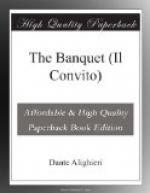is of better quality more or less, and stronger to
endure in one effect more than in another, being subject
to the nutriment of the heat, which is our life, it
happens that the arch of the life of one man is of
less or of greater extent than that of another, life
being shortened by a violent death or by some accidental
injury; but that which is called natural by the people
is that span of which it is said by the Psalmist, “Thou
settest up a boundary which it is not possible to
pass.” And since the Master among those
here living, Aristotle, had perception of this arch
of which we now speak, and seems to be of opinion
that our life should be no other than one ascent and
one descent, therefore he says, in that chapter where
he treats of Youth and of Old Age, that Youth is no
other than an increase of life. Where the top
of this arch may be, it is difficult to know, on account
of the inequality which has been spoken of above,
but for the most part I believe between the thirtieth
and the fortieth year, and I believe that in the perfectly
natural man it is at the thirty-fifth year. And
this reason has weight with me: that our Saviour
Jesus Christ was a perfect natural man, who chose to
die in the thirty-fourth year of His age; for it was
not suitable for the Deity to have place in the descending
segment; neither is it to be believed that He would
not wish to dwell in this life of ours even to the
summit of it, since He had been in the lower part even
from childhood. And the hour of the day of His
death makes this evident, for He willed that to conform
with His life; wherefore Luke says that it was about
the sixth hour when He died, that is to say, the height
or supreme point of the day; wherefore it is possible
to comprehend by that, as it were, that at the thirty-fifth
year of Christ was the height or supreme point of
His age. Truly this arch is not half distinguished
in the Scriptures, but if we follow the four connecting
links of the differing qualities which are in our composition,
to each one of which appears to be appropriated one
part of our age, it is divided into four parts, and
they are called the four ages. The first is Adolescence,
which is appropriated to the hot and moist; the second
is Youth, which is appropriated to the hot and dry;
the third is Old Age, which is appropriated to the
cold and dry; the fourth is Extreme Old Age, which
is appropriated to the cold and moist, as Albertus
Magnus writes in the fourth chapter of the Metaura.
And these parts or divisions are made in a similar
manner in the year—in Spring, in Summer,
in Autumn, and in Winter. And it is the same in
the day even to the third hour, and then even to the
ninth, leaving the sixth in the middle of this part,
or division, for the reason which is understood, and
then even to vespers, and from vespers onwards.
And therefore the Gentiles said that the chariot of
the Sun had four horses; they called the first Eoo,
the second Piroi, the third Eton, the fourth Phlegon,
even as Ovid writes in the second book of the Metamorphoses
concerning the parts or divisions of the day.




